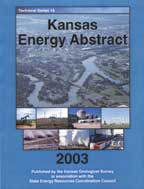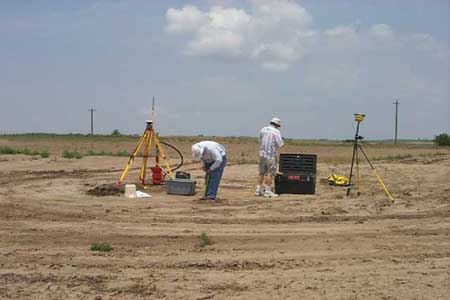Kansas Energy Abstract 2003
Kansas Energy Abstract 2003, compiled by Liz Brosius, Kansas
Geological Survey, and Scott White, Energy Research Center, University
of Kansas: KGS Technical Series 18, $15.00.
Ground-water Recharge in Kansas
Ground-water Recharge in Kansas, by Marios Sophocleous and Rex
Buchanan, Kansas Geological Survey: KGS Public Information Circular 22,
no charge.
Publications are available through Publications Sales (pubsales@kgs.ku.edu) at the Kansas Geological Survey, 1930 Constant Avenue, Lawrence, KS 66047-3726 (or call 785-864-2157). Prices do not include tax, shipping, and handling. More information about other Survey products is available at the Survey’s web site.
New
Publications

Kansas Energy Abstract 2003
Geophysicists at the Kansas Geological Survey have received a $2.3 million grant from the U.S. Department of Energy to use high-resolution seismic reflection to study the use of carbon dioxide to produce additional oil from a field in central Kansas.
The grant is the largest single contract ever awarded to the Survey.
Seismic reflection is somewhat similar to the sonograms used by physicians
and is commonly used in the oil industry to produce a detailed image of
the subsurface. A pulse of sound is set off at the earth’s surface,
usually through specially built trucks. The sound waves bounce off underground
rocks, then are recorded at the surface. Because different types of rocks
reflect the sound waves in different ways, the result can be used to create
an image of the subsurface, without drilling.
KU researchers and industry partners previously received a grant from the Department of Energy to test the use of carbon dioxide to flush additional oil from the Hall–Gurney field, southeast of Russell. This fall they plan to begin pumping carbon dioxide into the field’s oil-producing rocks, about 3,000 feet underground.
While carbon dioxide has been used to produce additional oil from long-established fields in other parts of country, it has not been tried in Kansas. Researchers believe it has the potential to push hundreds of millions of barrels of additional oil from Kansas fields, many of which are similar to the Hall–Gurney.
Survey geophysicists plan to obtain seismic data from the field before carbon dioxide is pumped underground. They will run additional seismic surveys while the carbon dioxide is being introduced, and again after the use of carbon dioxide at the field is completed.
“We want to see if seismic reflection can tell us exactly where the injected carbon dioxide is going, if it is producing oil efficiently, if there are areas where it is bypassing the oil, and how the use of carbon dioxide for enhanced recovery can be improved,” said Survey geophysicist Rick Miller. “This should tell us not only how well this enhanced-recovery project is working and help us adjust the way oil is produced, it will also help us learn if seismic reflection can be routinely used for monitoring carbon dioxide injection in other fields around the midcontinent.”

Preparing for the seismic-reflection survey of the Hull–Gurney field in Russell County.
Online Water Data
Next Page | Previous Page | GeoRecord Index | KGS Home
Comments to: lbrosius at kgs.ku.edu, Kansas Geological Survey
URL: http://www.kgs.ku.edu/Publications/GeoRecord/2003/vol9.3/Page3.html
Online December 15, 2003